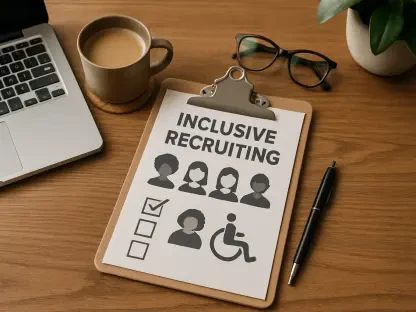Picture a bustling holiday shopping scene—crowds rushing through stores, festive music playing, and retail workers smiling through the chaos, but beneath those smiles lies a grim reality where many dread every customer interaction, bracing for hostility. A staggering 77% of UK retail workers report experiencing abuse this year, from sharp words to outright violence. What drives this alarming trend during a season meant for goodwill, and how can the tide be turned for those on the frontlines of Christmas commerce?
The Hidden Crisis Behind the Counter
This isn’t just a fleeting issue—it’s a pervasive problem shaking the foundation of the retail sector, a vital pillar of the UK economy. The significance of this crisis cannot be overstated: with millions relying on retail jobs, the well-being of these workers impacts not only individuals but entire communities. As the holiday rush intensifies, so does the urgency to understand why abuse has spiked and what it means for the industry’s future stability. Protecting retail staff is not just about fairness; it’s about sustaining a workforce that keeps the high street alive.
Uncovering the Scale of Hostility
Recent findings from a prominent retail charity reveal a distressing picture: 77% of shop workers have faced intimidation or abuse in the past year, with a 10% increase in weekly incidents compared to last year. Physical assaults affect 23% of these employees, while 43% endure verbal or physical attacks on a weekly basis. Beyond the raw numbers, the emotional impact is staggering—62% feel anxious about their shifts, and 45% report feeling unsafe at work. The Christmas season, with its heightened stress and packed stores, only amplifies this hostile environment, turning festive cheer into a daily gauntlet for many.
The ripple effects are evident in the industry’s retention challenges. With 43% of workers considering quitting due to mistreatment, the sector risks losing talent at a critical time. Shop floors are battlegrounds where stress and fear overshadow the holiday spirit, raising questions about how long this can persist without systemic collapse. These statistics paint a clear picture: retail work has become a high-risk occupation, not just physically but mentally, demanding immediate attention.
Voices of Struggle from the Shop Floor
Michael, a former store manager from Dundee, shares a haunting memory of his time in retail. “I’d wake up from nightmares about confrontations with shoplifters,” he recalls. “The daily hostility led to panic attacks, and I had to leave the industry.” His experience is far from unique—45% of surveyed workers note that treatment has worsened over the past two years, reflecting a deepening crisis. These personal accounts highlight a workforce feeling dehumanized, caught in a cycle of disrespect that chips away at their resilience.
Stephanie, a retailer from Conwy, Wales, adds another layer to the narrative. She describes how small customer behaviors—like ignoring greetings or staying glued to phones during transactions—strip away her sense of worth. “It’s as if I’m invisible,” she says. These subtle slights, combined with overt aggression, create a toxic atmosphere where workers feel undervalued, especially during the frenzied holiday period when patience often wears thin.
Industry leaders echo these concerns with urgency. Chris Brook-Carter, head of a leading retail support organization, states, “These workers are essential to our economy, yet they’re treated as disposable. Basic respect shouldn’t be a luxury.” His words underscore a collective frustration within the sector, where personal stories and authoritative voices converge on a shared truth: retail staff deserve better, particularly when the Christmas rush tests their limits.
Root Causes of a Growing Problem
Several factors fuel this surge in abuse, starting with societal impatience. Data shows 71% of shoppers admit to feeling annoyed with staff, while 13% have raised their voices or lost their temper. This frustration often spills over during peak shopping times, turning minor delays into flashpoints of conflict. The holiday season’s pressure-cooker environment only heightens these tensions, making retail workers easy targets for misplaced anger.
Retail crime, including shoplifting, adds a dangerous dimension. Workers are frequently thrust into confrontational roles, attempting to protect stock while risking personal safety. This dynamic creates a vicious cycle of stress and hostility, as employees face both criminal behavior and customer backlash. Additionally, social media trends—such as filming staff for pranks or viral content—introduce public humiliation into the mix, further eroding dignity in an already challenging job.
The consequences extend beyond the individual. With a significant portion of the workforce contemplating exit, the industry faces potential staffing shortages at a time when demand soars. A YouGov poll reveals that 34% of the public have witnessed rudeness toward staff, indicating a broader cultural issue of disrespect. Addressing these root causes requires more than policy—it demands a shift in how society views and interacts with those who serve on the frontlines.
Steps Toward Respect and Safety
Reversing this trend starts with small, intentional actions, especially during the high-stakes Christmas season. A campaign titled “Let’s Respect Retail” promotes a simple yet powerful idekindness matters. Shoppers are encouraged to make eye contact, offer a smile, or say thank you—gestures that take mere seconds but can brighten a worker’s day. Mindfulness in interactions, such as refraining from snapping over delays or filming staff without consent, can also make a tangible difference.
On a broader scale, systemic change is equally critical. Advocacy for legislative measures, like establishing assault on retail workers as a standalone offense, provides a legal backbone to protect staff. Retailers, too, are stepping up by enhancing training and safety protocols, with some major chains partnering with support organizations to prioritize employee well-being. These combined efforts—individual kindness and institutional action—offer a roadmap to restore humanity to the shopping experience.
Public awareness plays a pivotal role in sustaining momentum. Campaigns amplified through shopping centers and media remind consumers of their impact on workers’ lives. Supporting these initiatives, whether by spreading the message or engaging respectfully, empowers a cultural shift. The holiday season presents a unique opportunity to lead by example, showing that respect can be as much a gift as any item on a shelf.
Reflecting on a Path Forward
Looking back, the plight of retail workers during that Christmas season revealed a harsh truth about societal values. The staggering 77% abuse rate served as a wake-up call, exposing how easily frustration turns into hostility on the shop floor. Personal stories of fear and disillusionment lingered as stark reminders of the human cost behind the holiday rush. Yet, amidst the struggle, glimmers of hope emerged through campaigns championing kindness and industry pledges for safer workplaces.
The next steps demanded collective resolve—shoppers were urged to commit to small acts of decency, transforming routine interactions into moments of connection. Retailers faced pressure to bolster protections, ensuring staff no longer bore the brunt of societal tensions. Policymakers had a chance to cement legal safeguards, sending a clear message that abuse would not be tolerated. Above all, the season’s lessons underscored a timeless need: to see and value those who serve, building a future where every counter interaction reflects mutual respect.









